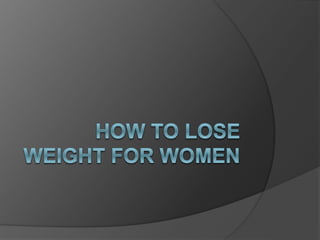
How to lose weight for women
- 2. As we get older, it becomes harder and harder to lose weight. Some women struggle with weight issues their entire lives.
- 3. When you add the stressors of everyday life, work duties, family life, and more, it can be very difficult to stay on the “weight loss wagon.”
- 4. Weight loss isn’t just about vanity. It’s also about your health. Health is one of the most important things that we have in life. When we are healthy, we feel better, and we physically have the ability to do most of the things that we want to do.
- 5. In turn, you also feel better all around. When you’re healthy, you’re more confident in your capabilities and your appearance.
- 6. There’s a lot of pressure in the media and pop culture telling women that they have to be perfect. They have to have to be good mothers, loving wives, breadwinners at their job, and still somehow maintain a perfect body. The focus, however, should not be on “perfection,” but rather on health.
- 7. Living a healthy lifestyle is no simple task. It can be very difficult to find a weight loss or health plan that works for you. It can be equally as hard to stick to that plan.
- 8. For example, you may decide that you want to start running. But once the weather gets icky, this plan may go down the drain. The next thing you know, you’re skipping your daily exercise routine and life is back to normal.
- 9. If you’ve been trying to lose weight and failing for years, it’s time to reassess your methods.
- 10. Let’s discuss some keys to help you get back on the wagon, stay on the wagon, and to lose weight.
- 11. Key 1: Stop and Think
- 12. Your brain and body work together. When approaching the topic of weight loss, it’s important to first sit down and discover the elements that have been contributing to your weight gain.
- 13. Have you slacked off on exercising? Are you too tired to exercise? How much sleep do you get each night? Is it enough?
- 14. Did you recently have a baby? When you were pregnant, did you put on a lot of extra weight? Have you had difficulty shedding these pounds?
- 15. Are you constantly stressed? What are the things that contribute to your stress? Do you overeat? Do you notice that you’re overeating while doing so, or do you only feel the results after a meal?
- 16. Have you experienced any major life changes that have affected your emotions?
- 17. Have you noticed that you’ve been eating more or that you instinctively choose junk foods over healthier foods?
- 18. What are you putting in your body on a daily basis? Are you taking any medications that potentially cause weight gain?
- 19. Are you doing everything correctly but still are unable to lose weight? Have you spoken to your doctor about any possible health issues.
- 20. To lose weight, you must be conscious of the things that are affecting your brain and body on a daily basis.
- 21. Do your part to get these elements under control. You have to make adjustments within your every day life so that you can increase your chances of success. Take steps that will help ensure that you start a weight loss plan and stick to it.
- 22. Key 2: Think Realistically and Positively
- 23. Keep your expectations in check. Don’t expect results overnight. It takes time to lose weight, build strength, and live an overall healthier lifestyle.
- 24. It’s important to decide specifically what you want to achieve, and then break that goal down into smaller, more manageable steps.
- 25. Be honest and specific with yourself. Don’t just say, “I need to lose weight,” or “I need to drop 100 pounds, stat.”
- 26. Consider how much you realistically need to lose. How much is possible over a specific period of time? Consider a valid reason that you want to lose weight or start exercising.
- 27. Here’s an example of a realistic, clear goal: “I would like to lose 20 pounds by next year so that I am in great shape for our next family vacation.”
- 28. Key 3: Get Moving
- 29. To stay healthy, your body needs to move. Exercise is critical, and it can have many positive mental and physical benefits.
- 30. When you’re first starting out, it doesn’t matter what you do. You can do little things, such as taking the stairs, taking a stroll around the block for 10-20 minutes during your lunch, or biking to locations instead of driving. Adjust little things, and you’ll start to notice a difference.
- 31. Keep things fresh so that you stay motivated and excited about improving your body. You can change your form of exercise or do something as simple as altering your route when running to keep your interest alive!
- 32. Key 4: Watch What You Eat
- 33. Food is vital for life. But to be your healthiest, you must watch what you eat. Not all foods are created equal. A lot of foods contribute to weight gain and poor health.
- 34. It can be easier to head to the vending machine or run to the convenience store for snacks than to actually take the time to prepare a quality dinner at home.
- 35. It can also be costly to purchase healthy foods. However, even though it’s time consuming and expensive, it’s also absolutely worth it.
- 36. Lastly, click here to discover how your every day “health foods” makes your cells sick, making it hard for you to lose that stubborn weight no matter how hard you try.